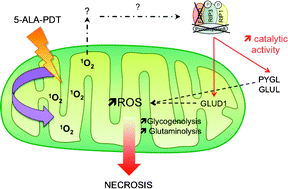 New insights in to the mechanism of action of 5-aminolevulinic acid (5-ALA) based photodynamic therapy (PDT) against glioblastoma reveal the involvement of receptor-interacting protein 3 (RIP3) in necrosis induction.
New insights in to the mechanism of action of 5-aminolevulinic acid (5-ALA) based photodynamic therapy (PDT) against glioblastoma reveal the involvement of receptor-interacting protein 3 (RIP3) in necrosis induction.
Glioblastoma are one of the most frequent and deadly brain tumours in human adults; prognosis with this type of cancer is very poor but 5-ALA-PDT has been emerging as a promising treatment. In this treatment 5-ALA is metabolized into the protoporphyrin IX (PPIX) photosensitizer inside mitochondria and PPIX preferentially accumulates into cancer cells due to their ferrochelatase deficiency.
This study from Jacques Piette and co-workers in Belgium is a result of the observation that 5-ALA-PDT treatment of glioblastoma leads to cell death by necrosis rather than apoptosis. It has become clear that cell death from necrosis is actually a programmed event rather than the accidental cell death it was long thought to be; this has coined the term necroptosis. Recent studies into the mechanism of necroptosis have revealed that a key effector is RIP3, a Ser/Thr kinase belonging to the RIP kinase family.
Jacques Piette and co-workers show that 5-ALA-PDT-induced necrosis in glioblastoma cells was dependent on RIP3 and that PDT-mediated singlet oxygen production is the cause of the RIP3-dependent necrotic pathway activation.
Further details are presented in their recently published Photochemical and Photobiological Sciences article which is free to access until 30th of November.
5-ALA-PDT induces RIP3-dependent necrosis in glioblastoma
Isabelle Coupienne, Grégory Fettweis, Noemí Rubio, Patrizia Agostinis and Jacques Piette
Photochem. Photobiol. Sci., 2011, DOI: 10.1039/C1PP05213F










